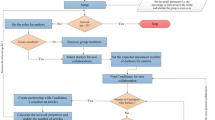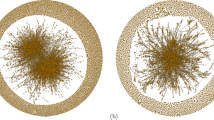Abstract
In this work we analyze the evolving dynamics of different strategies of collaborative networks that emerge from the creation and diffusion of knowledge. An evolutionary economic approach is adopted by introducing decision rules that are applied routinely and an agent-based model is developed. Firms (the agents) can collaborate and create networks for research and development purposes. We have compared three collaboration strategies (A—peer-to-peer complementariness, B—concentration process and C—virtual cooperation networks) that were defined on the basis of literature and on empirical evidence. Strategies are introduced exogenously in the simulation. The aims of this paper are twofold: (i) to analyze the importance of the networking effects; and (ii) to test the differences among collaboration strategies. It was possible to conclude that profit is associated with higher stock of knowledge and with smaller network diameter. In addition, concentration strategies are more profitable and more efficient in transmitting knowledge through the network. These processes reinforce the stock of knowledge and the profit of the firms located in the centers of the networks.




Similar content being viewed by others
Notes
According to Axelrod and Benett (1997), emergence is a consequence of local interaction of agents: the large-effects of complex locally interacting individuals endorse the appearance of emergent properties at the level of the population.
For the sake of simplification the index t is not considered in some expressions for which the time is not important in the analysis.
Several topologies are described in literature about collaboration networks, being these the most common topologies of the emerging networks. For a more detailed description of topologies, see Wilhite (2006).
MC change with the market. First we computed a marginal cost for each type of market according to a Normal distribution, as follows: market \({\mathrm{X}}: {\mathrm{MC}}_\mathrm{X}\sim {\mathrm{N}}(0.1, 0.01); {\mathrm{market}}\, {\mathrm{Y}}_{1}: {\mathrm{MC}}_\mathrm{Y1}\sim {\mathrm{N}}(0.05, 0.005); {\mathrm{market}} {\mathrm{Y}}_{2}: {\mathrm{MC}}_\mathrm{Y2}\sim {\mathrm{N}}(0.05, 0.005)\).
According to Scitovsky (1954), spillovers (or technological externalities) deal with the effects of non-market interactions, being realized through processes that affect the production (or profit) function of a firm. Spillovers may respect to the diffusion of learning across firms, which can take place through interfirm mobility of employees or cooperation.
Without loss of generality, we assume that \({\mathrm{D}}_\mathrm{tech} = 0.75\) and \({\mathrm{D}}_\mathrm{geo} = 0.25\), giving more importance to the technological distance than to the geographical one, which seems to be in line with empirical evidence.
Although the mechanisms underlying innovation are often unknown, we consider the use of the Normal distribution for updating \({\mathrm{w}}_\mathrm{i}^\mathrm{t}\) because there are many small and independent effects in the stock of knowledge that additively contribute to each observation. This model is in line with the work of Carayol and Roux (2005), in which networking allows the flow of R&D innovation to spread within a network and, consequently, to increase the stock of knowledge of other firms that are connected in the same network, as a function of the distance between nodes.
For instance, a final good producer (e.g. car makers) detains a specific stock of knowledge in its industry but may also hold some knowledge about intermediate goods industries (e.g. carburetors or clutches suppliers). Additionally, this complementarity may be incorporated in the definition of collaboration strategies (Sect. 3.4).
Following these stages, networks are created from the bottom up, according to individual decisions taken by firms. The aggregate behaviour (at network level) is produced by the interaction of individual agents. According to Axelrod and Benett (1997), these networks are defined as emergent in the scope of the multi-agent system.
If more than one firm satisfies the given condition, then one is chosen at random among the firms that are in the same conditions.
R is a language and environment for statistical computing and graphics (R Development Core Team 2010)
The Mann–Whitney test of independence presented the following \(p\) values: Profit \((<0.1\,\%)\), marginal cost (4 %), stock of knowledge (0.1 %). The Mann–Whitney test (Conover 1999), also known as the Mann–Whitney non parametric U test involves studying the position or ranking of data of two independent samples (defined by 1 and 2—in our case the two independent samples correspond to the grouping firms in networks and firms not in networks).
References
Alkemade, F., & Castaldi, C. (2005). Strategies for the diffusion of innovations on social networks. Computational Economics, 25, 3–23.
Audretsch, D. B., & Feldman, M. P. (2006). R &D spillovers & the geography of innovation & production. American Economic Review, 86(3), 630–640.
Axelrod, R., & Benett, S. (1997). A landscape theory of aggregation. In R. Axelrod (Ed.), The complexity of cooperation. Princeton, NJ: Princeton University Press.
Barabasi, A.-L. (2002). Linked: The new science of networks. Cambridge, MA: Perseus.
Baumol, W. J. (2002). Free market innovation machine: Analyzing the growth miracle of capitalism. Princeton, NJ: Princeton University Press.
Burt, R. S. (1992). Structural holes: The social structure of competition. Cambridge, MA: Harvard University Press.
Campos, P., Brazdil, P., & Brito, P. (2006). Organizational survival in cooperation networks: The case of automobile manufacturing. In L. Camarinha-Matos, H. Afsarmanesh, & M. Ollus (Eds.), Network-centric collaboration & supporting frameworks (pp. 77–84). Heidelberg : Springer.
Carayol, N., & Roux, P. (2005). Collective innovation in a model of network formation with preferential meeting. In Nonlinear dynamics & heterogeneous interacting agents—lecture notes in economics & mathematical systems (Vol. 550, Part III, pp. 139–153). Berlin, Heidelberg: Spinger-Verlag
Carroll, G., & Hannan, M. (1992). The demography of corporations & industries. Pinceton, NJ: Princeton University Press.
Cointet, J. P., & Roth, C. (2007). How realistic should knowledge diffusion models be? Journal of Artificial Societies & Social Simulation, 10(3), 5.
Cowan, R., Jonard, N., & Zimmerman, J. B. (2004). Networks as emergent structures from bilateral collaboration. MERIT–Infonomics Research memorandum series, 2004–17.
Csermely, P. (2006). Weak links: Stabilizers of complex systems from proteins to social networks. Berlin: Springer.
D’Agata, A., & Santangelo, G. (2003). Cognitive distance, knowledge spillovers & localisation in a duopolistic game. Catania: Mimeo.
D’Aspremont, C., & Jacquemin, A. (1988). Cooperative & noncooperative R &D in duopoly with spillovers. American Economic Review, 78(5), 1133–1137.
Dyer, J. H. (1996). Specialized supplier networks as a source of competitive advantage: Evidence from the auto industry. Strategic Management Joumal, 17, 271–291.
Ebers, M. (1997). Explaining inter-organizational network formation. In M. Ebers (Ed.), The formation of inter-organizational networks (pp. 3–40). New York: Oxford University Press.
Fujita, M., Krugman, P., & Venables, A. (1999). The spatial economy: Cities, regions & international trade. MIT, MA: The MIT Press.
Gulati, R., Nohria, N., & Zaheer, A. (2000). Strategic networks. Strategic Management Journal, 21, 203–215.
Hakansson, H. (1987). Industrial technological development: A network approach. London: Croom Helm.
Hakansson, H., & Snehota, I. (1995). Business networks. London: Routledge.
Jackson, M., & Wollinsky, A. (1996). A strategic model of social & economic networks. Journal of Economic Theory, 41, 44–74.
Jaffe, A. B. (1989). Real effects of academic research. American Economic Review, 79(5), 957–970.
Jaffe, A. B., Trajtenberg, M., & Henderson, R. (1993). Geographic localization of knowledge spillovers as evidenced by patent citations. Quarterly Journal of Economics, 108(3), 577–598.
Latora, V., & Marchoiri, M. (2003). Economic small-world behavior in weighted networks. The European Physical Journal B, 32(2), 249–263.
Leskovec, J., Kleinberg, J., & Faloutsos, C. (2005). Graphs over time: Densification laws, shrinking diameters & possible explanations. In International conference on knowledge discovery & data mining KDD’05. New York: ACM Press.
Lozano, S., Arenas, A., & Sanchéz, A. (2008). Community connectivity & heterogeneity: Clues & insights on cooperation on social networks. Journal of Economic Interaction & Coordination, 3(2), 183–199.
Milgram, S. (1967). The small-world problem. Psychology Today, 1, 62–67.
Mitchell, T. (1997). Machine learning. New York: McGraw Hill.
Nelson, R., & Winter, S. (1982). An evolutionary theory of economic change. Cambridge, MA: Belknap Press.
Nooy, W., Mrvar, A., & Batagelj, V. (2005). Exploratory social network analysis with Pajek structural analysis in the social sciences. Cambridge, MA: Cambridge University Press.
Quinlan, J. R. (1993). C4.5: Programs for machine learning. San Francisco, CA: Morgan Kaufmann Publishers Inc.
R Development Core Team. (2010). R: A language & environment for statistical computing. Vienna, Austria: R Foundation for Statistical Computing.
Schumpeter, J. A. (1996). [1942].Capitalism, socialism & democracy. London: Routledge.
Simon, H. (1955). A behavioral model of rational choice. The Quarterly Journal of Economics, 1, 99–118.
Scitovsky, T. (1954). Two concepts of external economies. Journal of Political Economy, 62, 142–151.
Swaminathan, A., Hoetker, G., & Mitchell, W. (2002). Network structure & business survival: The case of U.S. automobile component suppliers. Working Paper—University of Illinois at Urbana Champagne.
Tesfatsion, L. (2006). Agent-based computational economics: A constructive approach. In L. Tesfatsion & K. Judd (Eds.), Handbook of computational economics (Vol. 2, pp. 831–880). Amsterdam: Elsevier.
Varian, H. (2004). Microeconomic analysis (3rd ed., 1992). New York: W. W. Norton. Company, Inc.
Wang, S., & Archer, N. (2004). Supporting collaboration in business-to-business electronic market places. Information Systems & E-Business Management, 2(2–3), 269–286.
Watts, D. J., & Strogatz, S. H. (1998). Collective dynamics of ‘small-world’ networks. Nature, 393(6684), 440–442.
Wersching, K. (2005). Agglomeration in an innovative & differentiated industry with heterogeneous knowledge spillovers. In Workshop on regional agglomeration, growth & multilevel governance: The E.U. in a comparative perspective. Ghent: University of Gent.
Wilhite, A. (2006). Economic activity on fixed networks. In L. Tesfatsion & K. Judd (Eds.), Handbook of computational economics (Vol. 2, pp. 1015–1045). Amsterdam: Elsevier.
Young, L., & Wilkinson, I. F. (1989). The role of trust & co-operation in marketing channels: A preliminary study. European Journal of Marketing, 23(2), 109–122.
Young, H. P. (1998). Individual strategy and social structure: An evolutionary theory of institutions. Princeton, NJ: Princeton University Press.
Author information
Authors and Affiliations
Corresponding author
Rights and permissions
About this article
Cite this article
Campos, P., Brazdil, P. & Mota, I. Comparing Strategies of Collaborative Networks for R&D: An Agent-Based Study. Comput Econ 42, 1–22 (2013). https://doi.org/10.1007/s10614-013-9376-9
Accepted:
Published:
Issue Date:
DOI: https://doi.org/10.1007/s10614-013-9376-9




